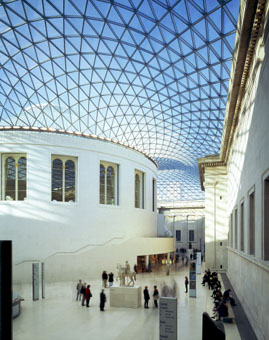
Image Courtesy of British Museum Society
Cultivating Curiosity
By Krista Tani | published Sunday, November 17, 2013 |
Thursday Review Contributor
I could feel tears welling up in my eyes. Not usually emotional, I quickly snapped my jaw shut and blinked like my life depended on it. There was no way I was going to cry in the British Museum. As I regained my senses, I took in the scene in front of me.
The light filtered through the iconic circular ceiling, casting a blue-green hue on the pristine tile floor as visitors flitted between the gift shop, library and exhibit entrances. This museum I had dreamed of visiting for years was even more impressive than I had imagined. I looked at my map, trying to strategize. I had four hours to see a museum in which I could spend days—challenge accepted.
Marching off to one of the exhibit areas, I stopped short when I saw the first object on display: the Rosetta Stone. Dating back to 196 BCE, the Rosetta Stone unlocked our contemporary understanding of ancient Egyptian hieroglyphs. As I stared at the small, precise markings that somehow came together to form language, my mind went in a hundred different directions. I marveled at the complexity of the three languages represented (ancient Egyptian, Demotic script, and ancient Greek) and wondered how they’ve changed over the centuries as they each move through history and among cultures. The craftsmanship of the script was impressive and I wondered who decided what would be written and who was tasked with the job of carrying it out. The Rosetta Stone contains a decree passed by a group of priests that tells of all the good that King Ptolemy V did for Egypt, and particularly for the priesthood, in his first year of rule. Neither they nor the thirteen year old king could have imagined the impact it would have...I could hardly believe I was actually standing in front of such a significant artifact. This experience of being transported across time and space was repeated time and time again as I moved through the museum, whether I stood before the Elgin Marbles that once adorned the Parthenon or a simple Chinese hairpin.
My experience with museums causing me to step back in time and wonder and question and imagine is not unique. Museums have the power to craft experiences that move beyond pure entertainment or education. By incorporating a wide range of mediums, engaging multiple senses, and addressing multiple learning styles, museums open a whole new realm of educational possibilities. The influence of museums is not confined to a single experience in a set point in time in a pretty (or not so pretty) building. Rather, the exhibits and programs that museums offer should serve as a jumping off point meant to propel visitors forward into their own explorations.
This is the unique power that museums hold: to go beyond the presentation of information to cultivate curiosity and inspire a love of learning.
